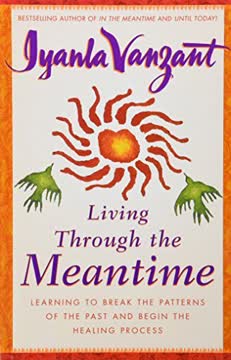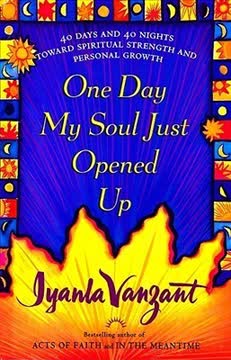Key Takeaways
1. Embrace the Meantime: Your Journey to Self-Discovery and Love
You are exactly where you need to be, doing exactly what you need to be doing in order to move into a higher consciousness.
The meantime is a transformative period. It's a time when you feel like your life is falling apart, but in reality, everything is about to come together. This phase is crucial for personal growth and self-discovery. During the meantime, you're given the opportunity to examine your past experiences, current feelings, and future desires.
Understanding the meantime stages is key:
- Basement: You've got a problem but don't know it
- First Floor: You've got a problem but don't know what it is
- Second Floor: You know the problem but don't know what to do about it
- Between Second and Third Floors: You know what to do but are afraid to do it
- Third Floor: You're ready to take responsibility and face challenges
- Attic: You're grateful, hopeful, ready, and open
By recognizing where you are in this process, you can better navigate your journey towards love and self-realization.
2. Identify Your Love Patterns: Understanding Your Emotional Triggers
Your earliest experiences with feminine energy create the essence of what you feel.
Our childhood experiences shape our love patterns. By examining our relationships with our parents or primary caregivers, we can understand the root of our emotional responses in current relationships. This awareness is crucial for breaking negative cycles and cultivating healthier connections.
Key steps to identify love patterns:
- Reflect on what your mother taught you about love
- Consider what your father taught you about love
- Analyze your first real love experience
- Examine the love you observed growing up
- Compare these patterns to your current or recent relationships
Understanding these patterns allows you to recognize emotional triggers and make conscious choices in your relationships, rather than reacting based on past experiences.
3. Confront and Clear Emotional Baggage: Shame, Guilt, Anger, and Fear
Spiritual healing requires a willingness to forgive, the courage to release fear, and readiness to relinquish anger, hatred, guilt, and shame.
Emotional baggage hinders personal growth and loving relationships. To move forward, it's essential to confront and clear these negative emotions. This process involves acknowledging past experiences, understanding their impact, and consciously choosing to release them.
Steps to clear emotional baggage:
- Identify specific experiences tied to shame, guilt, anger, and fear
- Acknowledge how these experiences have affected your beliefs and behaviors
- Recognize unloving actions or inactions resulting from these emotions
- Choose alternative, loving responses for similar situations in the future
- Declare your willingness to release thoughts, feelings, and behaviors tied to these negative emotions
By clearing this emotional baggage, you create space for more loving and fulfilling experiences in your life.
4. Recognize and Transform Unconscious Behaviors
People do what they do based on who they are and the information they have at the time. If they knew better, they would do better.
Unconscious behaviors often sabotage our relationships and personal growth. These behaviors are typically rooted in fear and manifest as fight, flight, freeze, or submit responses. By becoming aware of these patterns, we can make conscious choices to respond more lovingly.
Common unconscious behaviors and their alternatives:
- Fight: Instead of challenging or attacking, choose to communicate openly
- Flight: Rather than avoiding, address issues directly and honestly
- Freeze: Instead of becoming paralyzed, take small, manageable steps forward
- Submit: Rather than giving in to avoid conflict, express your needs and boundaries
Recognizing these patterns allows you to pause, reflect, and choose more constructive responses that align with your true desires and values.
5. Define Your Divine Self: Embrace Your True Identity
I am the Beloved. No thing and no one can change the truth of my being.
Embracing your divine self is crucial for authentic living and loving. This involves recognizing your inherent worth and the qualities that make you uniquely you. By defining and accepting your divine self, you create a solid foundation for all your relationships, especially romantic ones.
Steps to define your divine self:
- Identify qualities that describe your true essence
- Recognize what you deserve in life and relationships
- Understand how you create your experiences
- Acknowledge your power to shape your reality
By fully embracing your divine self, you attract relationships and experiences that align with your true nature and highest good.
6. Create Your Ideal Relationship: Clarify Your Desires and Expectations
One of the greatest, most loving gifts you can give to your partner is your wholeness.
Clarity about your ideal relationship is essential for manifesting it. This involves not only identifying the qualities you desire in a partner but also understanding the experience you want to create together. By being specific about your wants and needs, you increase the likelihood of attracting and maintaining a fulfilling relationship.
Key aspects to consider when defining your ideal relationship:
- Desired attributes in a partner
- How you want to feel in the relationship
- Decision-making processes
- Resource allocation
- Conflict resolution methods
- Your role in creating and maintaining the relationship
Remember that the most important relationship is the one you have with yourself. By cultivating self-love and wholeness, you become better equipped to create and nurture loving partnerships.
7. Practice Daily Acts of Faith: Strengthen Your Spiritual Connection
Through the conscious recognition of God in every situation, we never miss an opportunity to behold the Beloved, the precious Spirit inherent in each moment we encounter with another of God's creations.
Daily spiritual practice deepens your connection to the divine and enhances all aspects of life. The ACTS (Acknowledgment, Confession, Thanksgiving, Supplication) prayer process is a powerful tool for developing this connection. By consistently engaging in this practice, you align yourself with divine love and guidance.
Components of the ACTS prayer process:
- Acknowledgment: Recognize the divine presence in your life
- Confession: Admit unloving actions and forgive yourself
- Thanksgiving: Express gratitude for blessings received
- Supplication: Request support and guidance for specific needs
Incorporating this practice into your daily routine helps maintain a loving perspective and strengthens your ability to navigate life's challenges with grace and wisdom.
8. Live as the Beloved: Apply Love to Everything You Do
Behold! You are prepared to do a new thing! Be blessed!
Living as the Beloved means embodying love in all aspects of life. This is the ultimate goal of the meantime journey – to recognize your true nature as a divine expression of love and to manifest that love in every thought, word, and action.
Ways to live as the Beloved:
- Practice seeing the divine in every person and situation
- Respond to challenges with compassion and understanding
- Cultivate gratitude for all experiences, even difficult ones
- Offer love freely, without expectation of return
- Continuously seek ways to grow spiritually and emotionally
By consistently choosing love, you not only transform your own life but also become a beacon of light for others, inspiring them to embrace their own divine nature.
Last updated:
FAQ
1. What is "Living Through the Meantime" by Iyanla Vanzant about?
- Workbook for Healing: The book is a practical, interactive workbook designed to help readers break unhealthy patterns from the past and begin a process of emotional and spiritual healing.
- Metaphor of the House: Vanzant uses the metaphor of cleaning and renovating a house to represent the process of self-examination and transformation.
- Focus on Love and Self-Responsibility: The core message is about learning to love oneself, take responsibility for one’s experiences, and move from pain and confusion to clarity and self-acceptance.
- Step-by-Step Guidance: The book provides structured exercises, reflections, and affirmations to guide readers through different stages of healing, from awareness to acceptance and beyond.
2. Why should I read "Living Through the Meantime" by Iyanla Vanzant?
- Personal Growth Tool: It offers a hands-on approach for anyone seeking to heal from past hurts, break negative cycles, and improve their relationships.
- Accessible and Supportive: The workbook format makes it easy to engage with, providing clear steps and supportive exercises for self-discovery.
- Spiritual and Emotional Integration: Vanzant blends spiritual wisdom with practical advice, making it suitable for readers interested in holistic healing.
- Empowerment and Self-Love: The book emphasizes self-forgiveness, self-trust, and self-love as foundations for lasting change.
3. What are the key concepts and structure of "Living Through the Meantime"?
- The Meantime Metaphor: The "meantime" is described as a transitional period in life where healing and self-work are necessary before moving forward.
- The House Model: The book is structured around different "floors" of a house, each representing stages of healing: Basement (awareness), First Floor (identifying patterns), Second Floor (processing disappointment and betrayal), Third Floor (creating new experiences), and the Attic (spiritual practices).
- Triple A’s: Awareness, Acknowledgment, and Acceptance are central concepts for transforming unconscious patterns.
- Loving Behavior Reference: The book provides a checklist of loving behaviors to guide readers in making healthier choices.
4. How does Iyanla Vanzant define the "meantime" in "Living Through the Meantime"?
- Transitional Phase: The "meantime" is a period between the end of one phase and the beginning of another, often marked by confusion, pain, or uncertainty.
- Opportunity for Growth: Rather than being a time of suffering, it is reframed as a necessary working period for self-examination and healing.
- Not a Valley: Vanzant distinguishes the meantime from a "valley" experience, which is more about character development through hardship, while the meantime is about conscious evolution and clarity.
- Grounded in Love and Truth: The meantime is a sacred space for learning about love, truth, and self-responsibility.
5. What is the "house" metaphor and how does it structure the healing process in "Living Through the Meantime"?
- Basement to Attic Journey: Each level of the house represents a stage in the healing journey, from the basement (awareness of pain) to the attic (spiritual integration).
- Basement: Focuses on becoming aware of and acknowledging pain, disappointment, and blame.
- First and Second Floors: Address identifying love patterns, clearing emotional and mental triggers, and processing feelings like disappointment and betrayal.
- Third Floor and Attic: Emphasize creating new, loving experiences, spiritual practices, and daily acts of faith to maintain healing.
6. What are the "Triple A’s" (Awareness, Acknowledgment, Acceptance) in Iyanla Vanzant’s method?
- Awareness: Recognizing what you do when faced with fear, anger, or stress, and becoming conscious of habitual responses.
- Acknowledgment: Admitting to yourself and others the truth about your feelings and behaviors, without excuses or denial.
- Acceptance: Embracing your actions and experiences as valuable learning opportunities, and deciding if they serve your highest good.
- Foundation for Change: These steps are essential for breaking old patterns and making conscious, loving choices.
7. How does "Living Through the Meantime" by Iyanla Vanzant help readers identify and break negative love patterns?
- Love Pattern Survey: The book includes detailed exercises to explore what you learned about love from parents, caretakers, and early experiences.
- Self-Reflection Questions: Readers are guided to examine how these patterns influence current relationships and feelings about love.
- Forgiveness Practices: The workbook encourages forgiving oneself and others for past mistakes, which is key to breaking negative cycles.
- Rewriting the Narrative: By identifying and understanding these patterns, readers can consciously choose new, healthier ways to experience love.
8. What practical exercises and tools does Iyanla Vanzant provide in "Living Through the Meantime"?
- Journaling and Worksheets: The book is filled with prompts, surveys, and reflection questions for readers to write out their thoughts and feelings.
- Caring Exercises: Each section begins and ends with affirmations and self-care rituals to support emotional safety during the healing process.
- Trigger Word Lists: Positive and negative trigger words help readers articulate their emotions more clearly.
- Forgiveness and Affirmation Practices: Repetitive writing exercises (sometimes with the non-dominant hand) are used to reinforce self-forgiveness and new beliefs.
9. How does "Living Through the Meantime" address emotions like disappointment, betrayal, shame, guilt, anger, and fear?
- Dedicated Sections: Each emotion has its own section with definitions, guided questions, and exercises to process and release it.
- Root Cause Exploration: Readers are encouraged to identify the origins of these feelings and how they manifest in their lives.
- Healing Through Forgiveness: The book emphasizes forgiving oneself and others as a path to healing these emotions.
- Transformative Reframing: Vanzant teaches readers to see these emotions as opportunities for growth rather than sources of suffering.
10. What is the role of spirituality and daily practice in "Living Through the Meantime" by Iyanla Vanzant?
- Spiritual Foundation: The book integrates spiritual principles, affirmations, and prayers throughout the healing process.
- Daily Acts of Faith: Vanzant introduces the ACTS method (Acknowledgment, Confession, Thanksgiving, Supplication) as a daily spiritual practice.
- Practicing the Presence: Readers are encouraged to define and cultivate their own spirituality, love, and connection to the Divine.
- Ongoing Commitment: The attic section focuses on maintaining spiritual awareness and integrating love into daily life.
11. What are the key takeaways from "Living Through the Meantime" by Iyanla Vanzant?
- Self-Responsibility: Healing begins with taking responsibility for your own experiences and choices.
- Love as the Core: True transformation is grounded in self-love, forgiveness, and loving behavior toward others.
- Process Over Perfection: Healing is a journey, not a destination, and requires patience, self-compassion, and ongoing effort.
- Practical Tools: The book provides actionable exercises, affirmations, and spiritual practices to support lasting change.
12. What are some of the best quotes from "Living Through the Meantime" by Iyanla Vanzant and what do they mean?
- "You’ve got to clean the house before you can live in it!" – Healing requires honest self-examination and clearing out old pain before you can fully enjoy life.
- "Willingness is the key that transforms a character-developing experience into a soul-enhancing one." – Being open to growth and change is essential for deep healing.
- "If you are not giving and receiving love in all of your life’s experiences, you will find yourself in one meantime experience after another." – Love is the foundation for moving forward and breaking negative cycles.
- "I am the Beloved. No thing and no one can change the truth of my being." – Self-acceptance and recognizing your inherent worth are central to the healing process.
- "People do what they do based on who they are and the information they have at the time. If they knew better, they would do better." – This quote encourages compassion and forgiveness for both yourself and others.
Review Summary
Living Through the Meantime receives overwhelmingly positive reviews, with readers praising its inspirational and practical advice for coping with difficult times. Many found the book helpful during breakups or personal struggles. Readers appreciate Vanzant's straightforward approach, the workbook sections, and the house analogy for building a strong foundation. Some criticisms include repetitive questions and a writing style that can be overly dramatic. Overall, readers recommend the book for its ability to promote self-reflection, healing, and personal growth during challenging periods.
Download PDF
Download EPUB
.epub digital book format is ideal for reading ebooks on phones, tablets, and e-readers.












